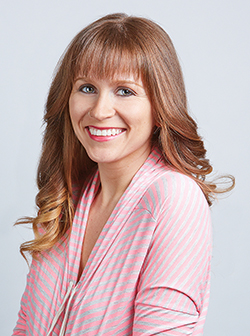Melanoma Survivor
Be Your Own Best Advocate
 As a typical, self-conscious teenager, Meghan Rothschild spent a lot of time in the sun trying to turn her fair skin golden brown. At 17, she tried a tanning bed and got hooked. For two and a half years, she used the tanning bed to tan consistently. At 19, she discovered a small black mole that began to itch and had it checked out. Shocked when she heard she had Stage II melanoma, she’s used her experience to educate other young people to protect their skin and prevent melanoma.
As a typical, self-conscious teenager, Meghan Rothschild spent a lot of time in the sun trying to turn her fair skin golden brown. At 17, she tried a tanning bed and got hooked. For two and a half years, she used the tanning bed to tan consistently. At 19, she discovered a small black mole that began to itch and had it checked out. Shocked when she heard she had Stage II melanoma, she’s used her experience to educate other young people to protect their skin and prevent melanoma.
When I was a sophomore in college, I noticed a small mole on my stomach about the size of a pencil eraser. I didn’t think much about it until it started to turn dark and began to itch. I’d catch myself scratching it when I was in the shower or lying in bed. It bothered me enough that I decided to get a checkup and see if it could just be removed.
I came home over winter break and saw a nurse practitioner. She said the mole was fine because it did not meet the criteria for melanoma. My mole was jet black, itchy and had regular borders. However, I had a gut feeling that something was not right. I felt strongly that I wanted the mole removed and asked the nurse practitioner for a referral to a dermatologist. At first, she refused and fought with me. I insisted and, eventually, she gave me a referral.
Two weeks before my 20th birthday, I had the mole removed. I thought it was no big deal, and I headed straight to the tanning salon after my surgery. When I returned to the doctor’s office two weeks later to have the stitches removed, I drove myself because I thought it would be a routine visit. However, when the doctor walked in, he asked if I had brought anyone with me. I told him I hadn’t, and he went on to say he was really sorry, but I had melanoma.
I was shocked and upset with myself. I knew I had done this to myself by spending time in a tanning bed and out in the sun without sunscreen. The doctor explained that he needed to see if melanoma had spread to my lymph nodes. He also would have to perform surgery to remove extra skin around the mole to make sure no cancer cells remained.
A few weeks before my surgery, he did a sentinel lymph node biopsy to see if the melanoma had spread to my lymph nodes. In the procedure, the doctor injected a radioactive dye to see if the lymph nodes would absorb the dye or if the dye would spread to other lymph nodes. This procedure showed him which lymph nodes would need to be removed during my scheduled surgery.
During the surgery, the surgeon removed seven lymph nodes from under my left arm and one under my right arm, which were biopsied to see if there was any cancer in those lymph nodes. He also removed extra skin around where the mole had been until I had clear margins.
When I woke up from surgery, I was surprised to find a bunch of netting and tubes sticking out of me. The doctor had sewn drainage tubes into each of the incisions where he removed the lymph nodes. He’d placed them so that I would not have any lymph fluid backup from the surgery. I didn’t expect to wake up to that, so it was kind of a shock.
I was in for another surprise when I returned to the doctor’s office three days later to have the drainage tubes removed. I had wondered how the doctor was going to remove the drainage tubes. This doctor, who had no bedside manner, just chuckled at me and said, “This is going to hurt.” He ripped out the tubes one by one, and it was terribly painful. That was the worst part of my entire experience. Two weeks after my surgery, my pathology results came back, and the doctor confirmed that the cancer had not spread to my lymph nodes. That’s when the doctors also confirmed that I had Stage II melanoma.
I now see a dermatologist twice a year for a skin exam, and I do my own skin check monthly to look for unusual moles. I hate to think what would have happened if I had not trusted myself to insist on getting a referral from that nurse practitioner. I didn’t know at the time that an itchy mole can be a symptom of melanoma, but I knew something wasn’t right about it.
I’ve turned my experience into an opportunity to teach others about the dangers of tanning beds and spending too much time in the sun without sunscreen. I volunteer for nonprofit organizations, and I’m the official spokesperson for IMPACT Melanoma, formerly the Melanoma Foundation of New England. Basically, I tell other young people not to do what I did when I was younger. I’ve also testified on Capitol Hill to help create legislation that prevents people under the age of 18 from using tanning beds.
I want to help prevent others from going through what I went through. Trust your gut. My advice, take charge and be your own best advocate for your health. If you feel something is wrong, get it checked.


